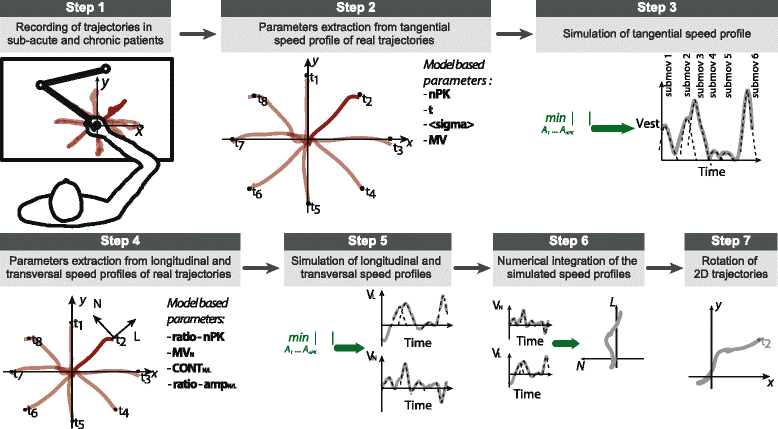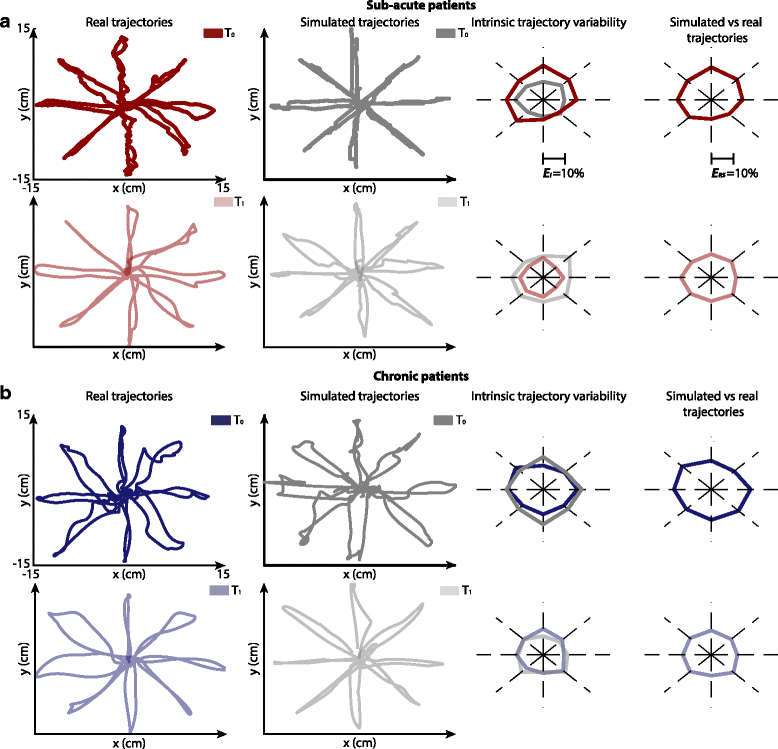Model-based variables for the kinematic assessment of upper-extremity impairments in post-stroke patients
- PMID: 27609062
- PMCID: PMC5016877
- DOI: 10.1186/s12984-016-0187-9
Model-based variables for the kinematic assessment of upper-extremity impairments in post-stroke patients
Abstract
Background: Common scales for clinical evaluation of post-stroke upper-limb motor recovery are often complemented with kinematic parameters extracted from movement trajectories. However, there is no a general consensus on which parameters to use. Moreover, the selected variables may be redundant and highly correlated or, conversely, may incompletely sample the kinematic information from the trajectories. Here we sought to identify a set of clinically useful variables for an exhaustive but yet economical kinematic characterization of upper limb movements performed by post-stroke hemiparetic subjects.
Methods: For this purpose, we pursued a top-down model-driven approach, seeking which kinematic parameters were pivotal for a computational model to generate trajectories of point-to-point planar movements similar to those made by post-stroke subjects at different levels of impairment.
Results: The set of kinematic variables used in the model allowed for the generation of trajectories significantly similar to those of either sub-acute or chronic post-stroke patients at different time points during the therapy. Simulated trajectories also correctly reproduced many kinematic features of real movements, as assessed by an extensive set of kinematic metrics computed on both real and simulated curves. When inspected for redundancy, we found that variations in the variables used in the model were explained by three different underlying and unobserved factors related to movement efficiency, speed, and accuracy, possibly revealing different working mechanisms of recovery.
Conclusion: This study identified a set of measures capable of extensively characterizing the kinematics of upper limb movements performed by post-stroke subjects and of tracking changes of different motor improvement aspects throughout the rehabilitation process.
Keywords: Kinematics; Modeling; Robotic rehabilitation; Stroke.
Figures





Similar articles
-
A neural tracking and motor control approach to improve rehabilitation of upper limb movements.J Neuroeng Rehabil. 2008 Feb 5;5:5. doi: 10.1186/1743-0003-5-5. J Neuroeng Rehabil. 2008. PMID: 18251996 Free PMC article.
-
Modifying upper-limb inter-joint coordination in healthy subjects by training with a robotic exoskeleton.J Neuroeng Rehabil. 2017 Jun 12;14(1):55. doi: 10.1186/s12984-017-0254-x. J Neuroeng Rehabil. 2017. PMID: 28606179 Free PMC article.
-
Kinematic measures for upper limb motor assessment during robot-mediated training in patients with severe sub-acute stroke.Restor Neurol Neurosci. 2016;34(2):237-45. doi: 10.3233/RNN-150565. Restor Neurol Neurosci. 2016. PMID: 26890098
-
Systematic Review on Kinematic Assessments of Upper Limb Movements After Stroke.Stroke. 2019 Mar;50(3):718-727. doi: 10.1161/STROKEAHA.118.023531. Stroke. 2019. PMID: 30776997
-
Kinematic measures for upper limb robot-assisted therapy following stroke and correlations with clinical outcome measures: A review.Med Eng Phys. 2018 Mar;53:13-31. doi: 10.1016/j.medengphy.2017.12.005. Epub 2018 Feb 1. Med Eng Phys. 2018. PMID: 29361407 Review.
Cited by
-
Kinematic Components of the Reach-to-Target Movement After Stroke for Focused Rehabilitation Interventions: Systematic Review and Meta-Analysis.Front Neurol. 2018 Jun 25;9:472. doi: 10.3389/fneur.2018.00472. eCollection 2018. Front Neurol. 2018. PMID: 29988530 Free PMC article.
-
Motor improvement estimation and task adaptation for personalized robot-aided therapy: a feasibility study.Biomed Eng Online. 2020 May 14;19(1):33. doi: 10.1186/s12938-020-00779-y. Biomed Eng Online. 2020. PMID: 32410617 Free PMC article.
-
Translational effects of robot-mediated therapy in subacute stroke patients: an experimental evaluation of upper limb motor recovery.PeerJ. 2018 Sep 4;6:e5544. doi: 10.7717/peerj.5544. eCollection 2018. PeerJ. 2018. PMID: 30202655 Free PMC article.
-
Neuroplastic Changes Following Brain Ischemia and their Contribution to Stroke Recovery: Novel Approaches in Neurorehabilitation.Front Cell Neurosci. 2017 Mar 16;11:76. doi: 10.3389/fncel.2017.00076. eCollection 2017. Front Cell Neurosci. 2017. PMID: 28360842 Free PMC article. Review.
-
Resting-state EEG topographies: Reliable and sensitive signatures of unilateral spatial neglect.Neuroimage Clin. 2020;26:102237. doi: 10.1016/j.nicl.2020.102237. Epub 2020 Mar 5. Neuroimage Clin. 2020. PMID: 32199285 Free PMC article.
References
-
- Gresham GE, Duncan PW, Stason WB. Post-stroke rehabilitation. Darby: DIANE Publishing; 1997.
MeSH terms
LinkOut - more resources
Full Text Sources
Other Literature Sources
Medical

